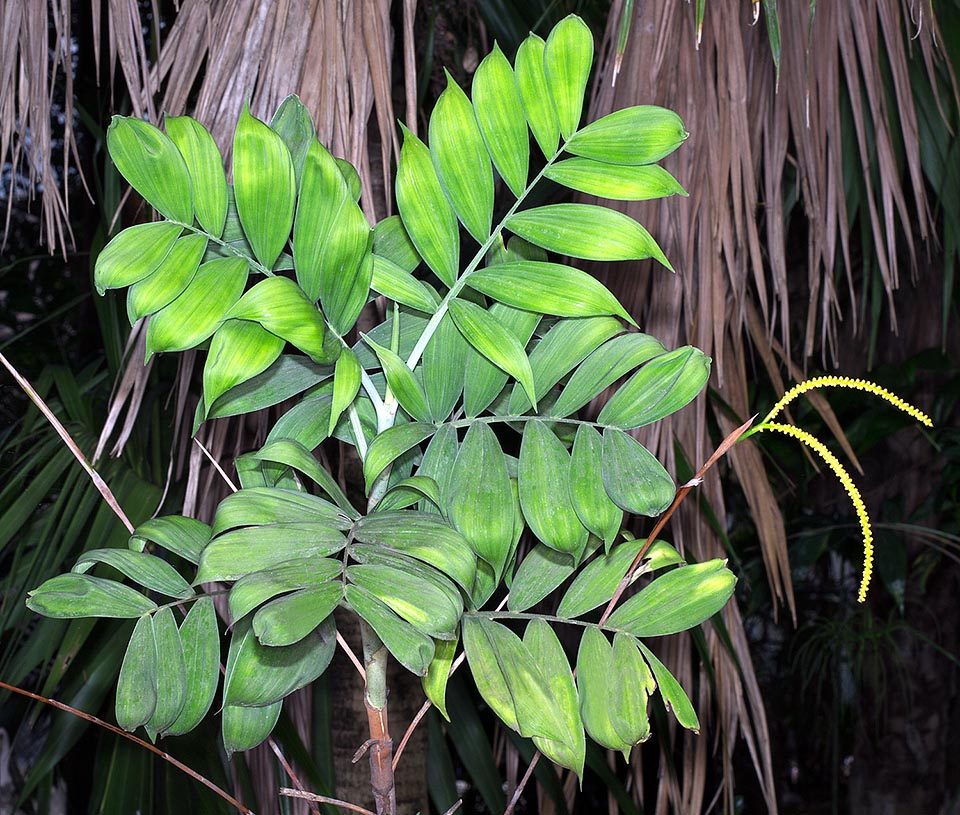Family : Arecaceae

Text © Pietro Puccio

English translation by Mario Beltramini
The species is native to Belize and Guatemala, where it lives in the underwood of the humid forests, on rocky soils mainly calcareous covered by a layer of decayed leaves, between 200 and 700 m of altitude.
The name of the genus is the combination of the Greek adverb “χαμαί” (chamai) = on the ground, on the soil, and of the substantive “δωρέα” (doréa) = gift, the German botanist Carl Ludwig Willdenow (1765-1812), who created the genus in 1806, did not specify the exact meaning of the name. The specific name is the adjective participle present of the Latin veb “adscendo” = to ascend, to climb, with reference to the stem.
Common names: velvet palm (English).
The Chamaedorea adscendens (Dammer) Burret (1933) is a rather variable dioecious species with solitary stems, erect, up to 2,5 m tall and of 0,8-1 cm of diameter, of green colour with the rings trace of the fallen leaves, spaced 2-2,5 cm, prominent. The leaves, on a 7-9 cm long petiole densely white dotted, are pinnate, rarely bifid, 15-20 cm long, with 2-6 leaflets per side, more or less alternate, obovate-lanceolate with long acuminate apex, 8-16 cm long and 2-3,5 cm broad, coriaceous, of grey-green or bluish green colour with a velvety look on the upper side. The tubular foliar base, open obliquely at the apex, of green grey colour dotted of white in the upper part, wraps totally the stem for a length of about 6 cm, persisting dry for long time. Inflorescences under the leaves (infrafoliar), on ascending peduncle, 40-60 cm long, initially green, then orange red when in fruit. Male inflorescences, 10-20 cm long, with 2-10 drooping rachillae of greenish colour bearing several close flowers of yellow colour, of about 2,5 mm of diameter, with 6 stamina. Female not ramified inflorescences with rachis, up to 15 cm long, initially of green colour, then red in fruit, with rather spaced flowers, ovoidal, slightly sunken into the rachis, of about 2,5 mm of diameter.

Native to the forests of Belize and Guatemala, between 200 and 700 m of altitude, Chamaedorea adscendens is a dioecious species that can be 2,5 m tall with 8-10 mm stems. Here, male specimen with the characteristic yellow inflorescences. Species endangered in nature, due to the strong anthropic pressure, rare also in cultivation © Giuseppe Mazza
Globose to ovoidal fruits, of about 0,8 cm of diameter, initially green, then glossy black when ripe, containing one only globose seed of about 0,6 cm of diameter.
It reproduces by seed, previously kept in water for two days, in draining loam maintained humid at the temperature of 24-26 °C, with germination times starting from 2-3 months.
Of ornamental value due to the unusual colour and the velvety look of the leaves, but fairly rare in cultivation, to employ solitary or in group in the tropical and subtropical gardens, its cultivation may be tried in the milder regions with warm temperate climate, where it can stand temperatures little less than 0°C, only if exceptional and short lasting. It requires slight shade or filtered sunlight and is not particular about the soil, slightly acidic to slightly alkaline, provided draining and maintained constantly humid, even of well rooted it may bear short periods of dry. For the fertilizations it is better to use slow-releasing products. Excellent subject to cultivate in pot for the decoration of outer spaces, where the climate allows so, and luminous inner spaces. In the closed spaces it may be subject to attacks of parasites, such as mites and mealy bugs, it is therefore to be controlled periodically in order to promptly act with specific products.
In nature, due to the anthropic pressure, the area occupied by the species has reduced and fragmented remarkably, for such reason it has been inserted in the red list of the IUCN (International Union for the Conservation of Nature) as “vulnerable” (species at risk of extinction).
Synonyms: Kinetostigma adscendens Dammer (1905); Tuerckheimia ascendens Dammer (1905).
→ For general notions about ARECACEAE please click here.
